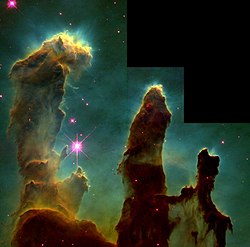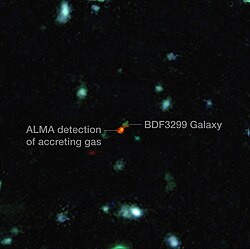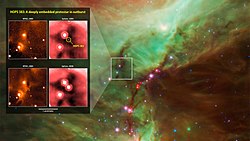Star formation
Star formation means the earliest stages in a star's life. Dense regions of particles exist in molecular clouds known as "stellar nurseries". The clouds collapse under gravitation into spheres of plasma to form stars.
Stellar nurseries
High density regions of the interstellar medium (ISM) form clouds, or nebulae, where star formation takes place.[1]
Dense nebulae
In the dense nebulae where stars are produced, much of the hydrogen is in the molecular (H2) form, so these nebulae are called molecular clouds.[1] The largest such formations, giant molecular clouds, have densities of 100 particles per cm3, diameters of 100 light-years (9.5×1014 km), and masses up to 6 million solar masses,[2] and an average interior temperature of 10 K. About half the total mass of the galactic ISM is found in molecular clouds.[3] In the Milky Way there are about 6,000 molecular clouds, each with more than 100,000 solar masses.[4] The nearest nebula to the Sun where massive stars are being formed is the Orion nebula, 1,300 ly (1.2×1016 km) away.[5] However, lower mass star formation is occurring about 400–450 light years distant in the ρ Ophiuchi cloud complex.[6]
A more compact site of star formation is the opaque clouds of dense gas and dust known as Bok globules; so named after the astronomer Bart Bok.[7] The Bok globules are typically up to a light year across and contain a few solar masses.[8] They can be seen as dark clouds against bright emission nebulae or background stars. Over half the known Bok globules have been found to contain newly forming stars.[9]
Spiral galaxies
A spiral galaxy like the Milky Way contains stars, the remains of stars (stellar remnants) and a diffuse interstellar medium (ISM) of gas and dust. The interstellar medium consists of 10–4 to 106 particles per cm3 usually of about 70% hydrogen by mass, with most of the remaining gas consisting of helium. This medium is chemically enriched by trace amounts of heavier elements that were ejected from stars as they passed beyond the end of their main sequence lifetime.
Elliptical galaxies
In contrast to spirals, an elliptical galaxy loses the cold component of its interstellar medium within about a billion years. This hinders the galaxy from forming diffuse nebulae except through mergers with other galaxies.[10]
W75N(B)-VLA2
This is a massive protostar about 300 times brighter than our Sun. Astronomers have caught a key stage in the birth of a very heavy star. They used two radio telescope views of the process 18 years apart. The young star is 4,200 light-years from Earth and is surrounded by a doughnut-shaped cloud of dust.
The first observation was in 1996. By 2015 its stellar wind changed from a compact spherical form to a larger, ionized elliptical shape. This gave information about what happens as a massive star forms.[11][12] Being able to observe its rapid growth is unique, according to Huib van Langevelde of Leiden University, one of the authors of a study of the object.
Star Formation Media
Westerhout 51 nebula in Aquila – one of the largest star factories in the Milky Way (August 25, 2020)
ALMA observations of the Orion Nebula complex provide insights into explosions at star birth.
Dwarf galaxy ESO 553-46 has one of the highest rates of star formation of the 1000 or so galaxies nearest to the Milky Way.
Composite image showing young stars in and around molecular cloud Cepheus B
Star formation region Lupus 3
References
- ↑ 1.0 1.1 Prialnik, Dina 2000. An introduction to the theory of stellar structure and evolution. Cambridge University Press. 195–212. ISBN 0-521-65065-8.
- ↑ Williams J.P; Blitz L. & McKee C F. 2000. The structure and evolution of molecular clouds: from clumps to cores to the IMF. In Protostars and Planets IV, 97.
- ↑ Alves J; Lada C. & Lad, E. 2001. (6 November 2000). "Tracing H2 Via infrared dust extinction". Molecular hydrogen in space. Cambridge University Press. p. 217. ISBN 0-521-78224-4.
{{cite book}}: CS1 maint: multiple names: authors list (link) - ↑ Sanders D.B.; Scoville N.Z. & Solomon P M. 1985. (1985). "Giant molecular clouds in the galaxy. II – Characteristics of discrete features". Astrophysical Journal, Part 1. 289: 373–387. Bibcode:1985ApJ...289..373S. doi:10.1086/162897.
{{cite journal}}: CS1 maint: multiple names: authors list (link) - ↑ Sandstrom, Karin M. (2007). "A parallactic distance of [math]\displaystyle{ 389^{+24}_{-21} }[/math] parsecs to the Orion Nebula cluster from very long baseline array observations". The Astrophysical Journal. 667 (2): 1161. arXiv:0706.2361. Bibcode:2007ApJ...667.1161S. doi:10.1086/520922. S2CID 18192326.
- ↑ Wilking B A.; Gagné M. & Allen L E. 2008. Star formation in the ρ Ophiuchi molecular cloud (2008). In Bo Reipurth (ed.). Handbook of star forming regions, Volume II: The Southern Sky ASP Monograph Publications. arXiv:0811.0005. Bibcode:2008hsf2.book..351W.
{{cite book}}: CS1 maint: multiple names: authors list (link) - ↑ Khanzadyan T. et al. 2002. Active star formation in the large Bok globule CB 34 (2002). "Active star formation in the large Bok globule CB 34". Astronomy and Astrophysics. 383 (2): 502–518. Bibcode:2002A&A...383..502K. doi:10.1051/0004-6361:20011531. S2CID 15524718.
- ↑ Hartmann, Lee (2000). Accretion processes in star formation. Cambridge University Press. p. 4. ISBN 0-521-78520-0.
- ↑ Smith, Michael David (2004). The origin of stars. Imperial College Press. p. 43–44. ISBN 1-86094-501-5.
- ↑ Dupraz C. & Casoli F. 1990. The fate of the molecular gas from mergers to ellipticals. In Dynamics of galaxies and their molecular cloud distributions. Proceedings of the 146th Symposium of the International Astronomical Union, Kluwer.
- ↑ Carrasco-Gonzalez C. et al 2015. Observing the onset of outflow collimation in a massive protostar. Science 348 (6230) p114. [1]
- ↑ BBC News: Star's birth glimpsed 'in real time', 3 April 2015










